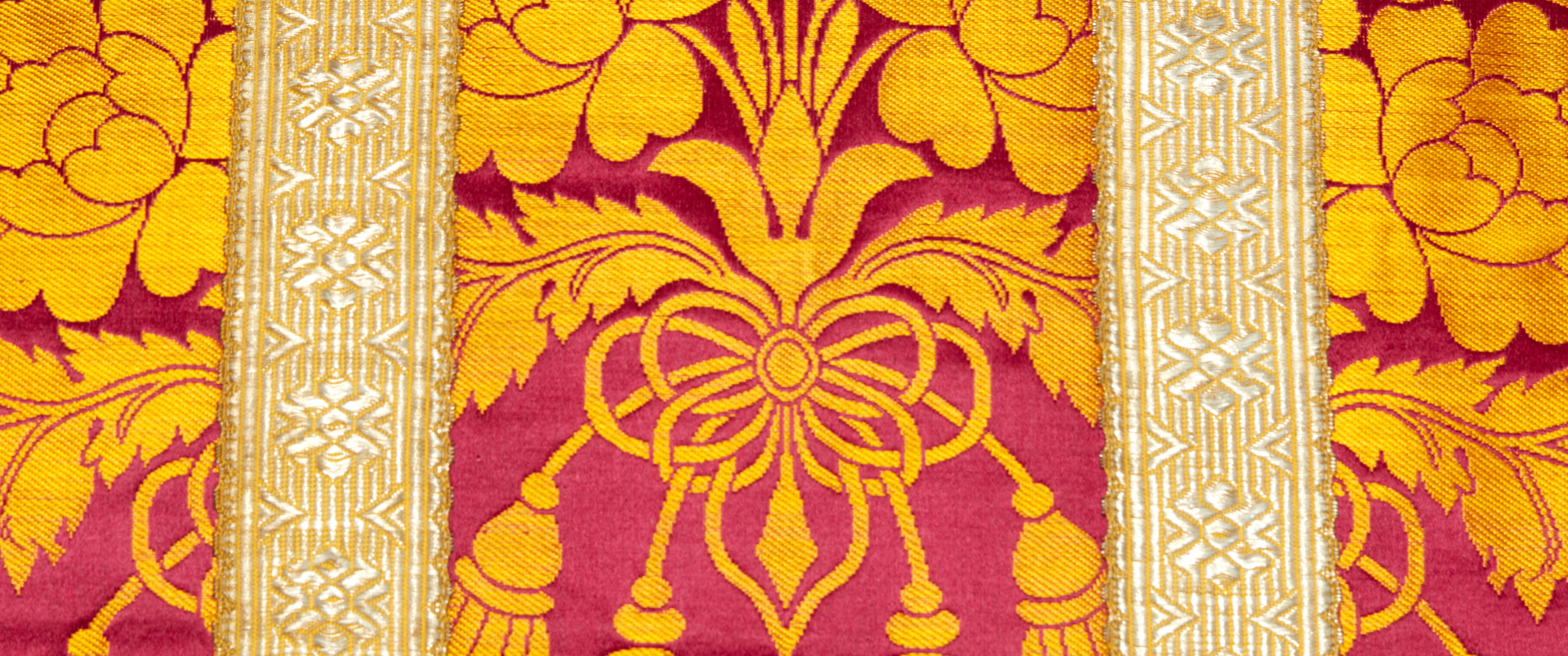
EARLY CALIFORNIA VESTMENTS AND LITURGICAL TEXTILES COLLECTION
The William H. Hannon Library's Early California Vestments and Liturgical Textiles collection provides enduring access to Rancho and Mission-era liturgical clothing used in California Catholic churches and missions during the eighteenth and nineteenth centuries. These fragile and culturally significant garments were the first collection selected for digitization through the Costume Society of America's (CSA) endowment pilot program "Digital Angels" which aimed to assist organizations by training staff and volunteers to digitize their holdings of historic dress.
Most of the pieces in this collection were donated by Josefa del Valle de Forster to Loyola University in the 1940s for inclusion in the Ygnacio del Valle Family collection. They are believed to have been given to her by Father José María de Jesús González Rubio who brought them each month from Nuestra Señora Reina de los Angeles (“Our Lady, Queen of the Angels”) when he would offer Mass in the del Valle family chapel at Rancho Camulos, located on the tribal ancestral territory of the Fernandeño Tataviam Band of Mission Indians. The del Valle family were a Californio family who, in 1839, received a land grant from the government of Mexico for the 48,000-acre ranch known as Rancho San Francisco. The family home at Camulos achieved fame in the late nineteenth century as the residence of Ramona, the fictional heroine from Helen Hunt Jackson's 1884 novel Ramona.
Notes also indicate some vestments were a gift from Bishop Francisco Mora y Borrell of Los Angeles who presided over the wedding at Rancho Camulos of Josefa del Valle and John Forster, whose family settled Rancho Santa Margarita on the ancestral tribal territory of the Gabrielino-Tongva Indian tribe.
Items orginating outside of the Ygnacio del Valle Family collection include gifts of a white floral cope from Mr. and Mrs. Emil K. Rossiter and a black velvet cope from Father Thomas English.
EARLY CALIFORNIA VESTMENTS AND LITURGICAL TEXTILES COLLECTION
The William H. Hannon Library's Early California Vestments and Liturgical Textiles collection provides enduring access to Rancho and Mission-era liturgical clothing used in California Catholic churches and missions during the eighteenth and nineteenth centuries. These fragile and culturally significant garments were the first collection selected for digitization through the Costume Society of America's (CSA) endowment pilot program "Digital Angels" which aimed to assist organizations by training staff and volunteers to digitize their holdings of historic dress.
Most of the pieces in this collection were donated by Josefa del Valle de Forster to Loyola University in the 1940s for inclusion in the Ygnacio del Valle Family collection. They are believed to have been given to her by Father José María de Jesús González Rubio who brought them each month from Nuestra Señora Reina de los Angeles (“Our Lady, Queen of the Angels”) when he would offer Mass in the del Valle family chapel at Rancho Camulos, located on the tribal ancestral territory of the Fernandeño Tataviam Band of Mission Indians. The del Valle family were a Californio family who, in 1839, received a land grant from the government of Mexico for the 48,000-acre ranch known as Rancho San Francisco. The family home at Camulos achieved fame in the late nineteenth century as the residence of Ramona, the fictional heroine from Helen Hunt Jackson's 1884 novel Ramona.
Notes also indicate some vestments were a gift from Bishop Francisco Mora y Borrell of Los Angeles who presided over the wedding at Rancho Camulos of Josefa del Valle and John Forster, whose family settled Rancho Santa Margarita on the ancestral tribal territory of the Gabrielino-Tongva Indian tribe.
Items orginating outside of the Ygnacio del Valle Family collection include gifts of a white floral cope from Mr. and Mrs. Emil K. Rossiter and a black velvet cope from Father Thomas English.
Acknowledgements
The William H. Hannon Library is grateful for support from the Bill Hannon Foundation and the Costume Society of America that made possible the digitization of the Early California Vestments and Liturgical Textiles collection. The William H. Hannon Library also acknowledges the work of photographer Robert Macaisa for capturing the images included in the digital collection.
Acknowledgements
The William H. Hannon Library is grateful for support from the Bill Hannon Foundation and the Costume Society of America that made possible the digitization of the Early California Vestments and Liturgical Textiles collection. The William H. Hannon Library also acknowledges the work of photographer Robert Macaisa for capturing the images included in the digital collection.
